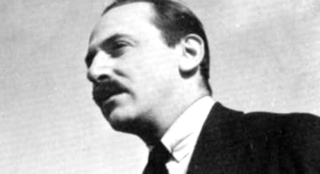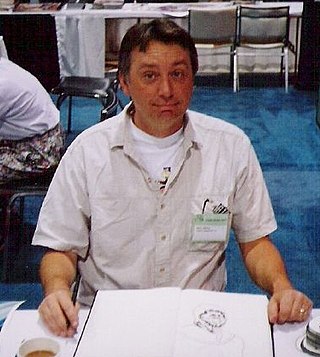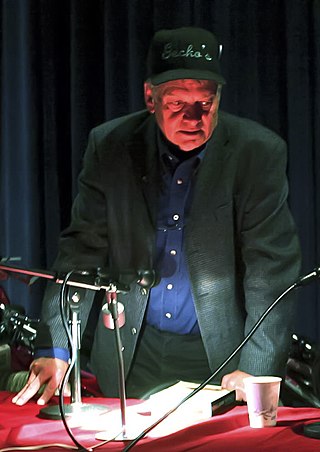
Mormonism is the theology and religious tradition of the Latter Day Saint movement of Restorationist Christianity started by Joseph Smith in Western New York in the 1820s and 1830s. As a label, Mormonism has been applied to various aspects of the Latter Day Saint movement, although since 2018 there has been a push from The Church of Jesus Christ of Latter-Day Saints to distance themselves from this label. A historian, Sydney E. Ahlstrom, wrote in 1982 that, depending on the context, the term Mormonism could refer to "a sect, a mystery cult, a new religion, a church, a people, a nation, or an American subculture; indeed, at different times and places it is all of these."

Catch-22 is a satirical war novel by American author Joseph Heller. It is his debut novel. He began writing it in 1953; the novel was first published in 1961. Often cited as one of the most significant novels of the twentieth century, it uses a distinctive non-chronological third-person omniscient narration, describing events from the points of view of different characters. The separate storylines are out of sequence so the timeline develops along with the plot.

Gibran Khalil Gibran, usually referred to in English as Kahlil Gibran, was a Lebanese-American writer, poet and visual artist; he was also considered a philosopher, although he himself rejected the title. He is best known as the author of The Prophet, which was first published in the United States in 1923 and has since become one of the best-selling books of all time, having been translated into more than 100 languages.

Catch Me If You Can is a 2002 American biographical crime comedy-drama film directed and produced by Steven Spielberg and starring Leonardo DiCaprio and Tom Hanks with Christopher Walken, Martin Sheen, Nathalie Baye, Amy Adams, and James Brolin in supporting roles. The screenplay by Jeff Nathanson is based on the semi-autobiographical book of the same name by Frank Abagnale Jr., who claims that prior to his 19th birthday, he successfully performed cons worth millions of dollars by posing as a Pan American World Airways pilot, a Georgia doctor, and a Louisiana parish prosecutor. The truth of his story is heavily disputed.

Garth Ennis is a Northern Irish-American comics writer, best known for the Vertigo series Preacher with artist Steve Dillon, his nine-year run on Marvel Comics' Punisher franchise, and The Boys with artist Darick Robertson. He has collaborated with artists such as Dillon and Glenn Fabry on Preacher, John McCrea on Hitman, Marc Silvestri on The Darkness, and Carlos Ezquerra on both Preacher and Hitman. His work has won him recognition in the comics industry, including nominations for the Comics Buyer's Guide Award for Favorite Writer in 1997, 1998, 1999, and 2000.

Nathanael West was an American writer and screenwriter. He is remembered for two darkly satirical novels: Miss Lonelyhearts (1933) and The Day of the Locust (1939), set respectively in the newspaper and Hollywood film industries.

Anthony Robert Kushner is an American author, playwright, and screenwriter. Lauded for his work on stage, he is most known for his seminal work Angels in America, which earned a Pulitzer Prize and a Tony Award, as well as its subsequent acclaimed HBO miniseries of the same name. At the turn of the 21st century, he became known for his numerous film collaborations with Steven Spielberg. He received the National Medal of Arts from President Barack Obama in 2013. Kushner is among the few playwrights in history nominated for an Emmy, Grammy, Oscar, and Tony Award.

Sidney Joseph Perelman was an American humorist and screenwriter. He is best known for his humorous short pieces written over many years for The New Yorker. He also wrote for several other magazines, including Judge, as well as books, scripts, and screenplays. Perelman received an Academy Award for screenwriting in 1956.

Life in Hell is a comic strip by Matt Groening that was published weekly from 1977 to 2012. The strip features anthropomorphic rabbits and a gay couple. The comic covers a wide range of subjects, such as love, sex, work, and death, and explores themes of angst, social alienation, self-loathing, and fear of inevitable doom.
K. H. Ting, Ting Kuang-hsun or Ding Guangxun, was Chairperson emeritus of the Three-Self Patriotic Movement (TSPM) and President emeritus of the China Christian Council, the government-approved Protestant church in China.

Richard Veitch is an American comics artist and writer who has worked in mainstream, underground, and alternative comics.

Terry Ballantine Bisson was an American science fiction and fantasy author. He was best known for his short stories, including "Bears Discover Fire", which won the Hugo Award and the Nebula Award, and "They're Made Out of Meat".

Gershom Scholem was a German-born Israeli philosopher and historian. Widely regarded as the founder of modern academic study of the Kabbalah, Scholem was appointed the first professor of Jewish mysticism at Hebrew University of Jerusalem.

Pantheon Books is an American book publishing imprint. Founded in 1942 as an independent publishing house in New York City by Kurt and Helen Wolff, it specialized in introducing progressive European works to American readers. In 1961, it was acquired by Random House, and André Schiffrin was hired as executive editor, who continued to publish important works, by both European and American writers, until he was forced to resign in 1990 by Random House owner Samuel Irving Newhouse, Jr. and president Alberto Vitale. Several editors resigned in protest, and multiple Pantheon authors including Studs Terkel, Kurt Vonnegut, and Barbara Ehrenreich held a protest outside Random House. In 1998, Bertelsmann purchased Random House, and the imprint has undergone a number of corporate restructurings since then. It is now part of the Knopf Doubleday Publishing Group under Penguin Random House.

\

Joseph Heller was an American author of novels, short stories, plays, and screenplays. His best-known work is the 1961 novel Catch-22, a satire on war and bureaucracy, whose title has become a synonym for an absurd or contradictory choice. He was nominated in 1972 for the Nobel Prize in Literature.

Kathleen Freeman was a British classical scholar and author of detective novels. Her detective fiction was published under the pseudonym Mary Fitt. Freeman was a lecturer in Greek at the University College of South Wales and Monmouthshire, Cardiff, between 1919 and 1946.

Alan Moore is an English author known primarily for his work in comic books including Watchmen, V for Vendetta, The Ballad of Halo Jones, Swamp Thing, Batman: The Killing Joke, and From Hell. He is widely recognised among his peers and critics as one of the best comic book writers in the English language. Moore has occasionally used such pseudonyms as Curt Vile, Jill de Ray, Brilburn Logue, and Translucia Baboon; also, reprints of some of his work have been credited to The Original Writer when Moore requested that his name be removed.

Nineteen Eighty-Four is a dystopian novel and cautionary tale by English writer George Orwell. It was published on 8 June 1949 by Secker & Warburg as Orwell's ninth and final book completed in his lifetime. Thematically, it centres on the consequences of totalitarianism, mass surveillance, and repressive regimentation of people and behaviours within society. Orwell, a staunch believer in democratic socialism and member of the anti-Stalinist Left, modelled the Britain under authoritarian socialism in the novel on the Soviet Union in the era of Stalinism and on the very similar practices of both censorship and propaganda in Nazi Germany. More broadly, the novel examines the role of truth and facts within societies and the ways in which they can be manipulated.

"This Hell" is a song by Japanese-British singer Rina Sawayama from her second studio album, Hold the Girl (2022). It was released through Dirty Hit on 18 May 2022 as the lead single from the album.



















